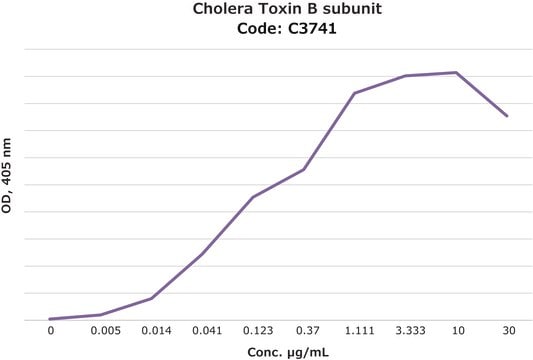C1655
Cholera Toxin B subunit
FITC conjugate, lyophilized powder
Synonym(s):
CTB
About This Item
Recommended Products
conjugate
FITC conjugate
Quality Level
form
lyophilized powder
mol wt
~12 kDa
composition
Protein, ~20% Lowry
extent of labeling
~1.0 mol FITC per mol protein
storage temp.
2-8°C
SMILES string
CCOc1ccccc1C(=O)Nc2ccc(Cl)c(c2)C(F)(F)F
InChI
1S/C16H13ClF3NO2/c1-2-23-14-6-4-3-5-11(14)15(22)21-10-7-8-13(17)12(9-10)16(18,19)20/h3-9H,2H2,1H3,(H,21,22)
InChI key
YDXZSNHARVUYNM-UHFFFAOYSA-N
Looking for similar products? Visit Product Comparison Guide
Application
- to label distal cerebrospinal fluid-contacting neurons (dCSF-CNs) in lateral ventricles of rat
- to stain epididymal sperms of mice
- to stain peritoneal macrophages of mice
Biochem/physiol Actions
Features and Benefits
Physical form
Analysis Note
Signal Word
Warning
Hazard Statements
Precautionary Statements
Hazard Classifications
Acute Tox. 4 Inhalation - Aquatic Chronic 3
Storage Class Code
11 - Combustible Solids
WGK
WGK 2
Flash Point(F)
Not applicable
Flash Point(C)
Not applicable
Certificates of Analysis (COA)
Search for Certificates of Analysis (COA) by entering the products Lot/Batch Number. Lot and Batch Numbers can be found on a product’s label following the words ‘Lot’ or ‘Batch’.
Already Own This Product?
Find documentation for the products that you have recently purchased in the Document Library.
Customers Also Viewed
Our team of scientists has experience in all areas of research including Life Science, Material Science, Chemical Synthesis, Chromatography, Analytical and many others.
Contact Technical Service















